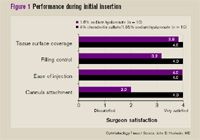Article
Randomized study compares two OVDs
Aspects of the intraoperative performance of two ophthalmic viscosurgical devices (OVDs) were prospectively evaluated during a single-surgeon, randomized study. Both agents worked well, but the results showed clear differences favoring a cohesive OVD of 1.6% sodium hyaluronate (Amvisc Plus, Bausch & Lomb) over a viscous-dispersive OVD of 4% chondroitin sulfate and 1.65% sodium hyaluronate (DisCoVisc, Alcon Laboratories).

Key Points

John D. Hunkeler, MD, , medical director, Hunkeler Eye Institute, Overland Park, KS, conducted a prospective study evaluating the two OVDs in 20 eyes undergoing phacoemulsification with foldable IOL implantation. Using a scale of 1 (dissatisfied) to 4 (very satisfied), Dr. Hunkeler rated his satisfaction with the performance of each product during the initial insertion, capsulorhexis, phaco, IOL implantation, and removal as well as with respect to overall performance, overall ease of use, and price.
Both OVDs received the highest ratings for performance during capsulorhexis and IOL implantation. The results for all other assessments favored the cohesive OVD, however.

Neither OVD presented any problems during capsulorhexis, and each achieved an average rating of 4 for its performance during that phase of the surgery.
"With both agents, there was sufficient inflation of the anterior chamber, good anterior chamber visualization, and adequate maintenance of a taut capsular bag surface and deep anterior chamber," Dr Hunkeler said.
Both OVDs also achieved the highest average rating of 4 for performance during phaco, in which they were judged for continuity of surface coverage, posterior chamber visualization, entrapment of air bubbles, removal of air bubbles, and retention in the anterior chamber during and after phaco. Although no other performance issues occurred with the cohesive OVD during phaco, when using the viscous-dispersive OVD, Dr. Hunkeler experienced phaco needle clogging during initial sculpting or debulking of the anterior surface of the lens in three eyes, which made the procedure more difficult, he said. In addition, poor aspiration of the viscous-dispersive OVD during sculpting in one case necessitated an increase in the vacuum level.
"After completing the hydrodissection and when beginning to debulk the anterior portion of the lens, my vacuum setting of 80 mm Hg was insufficient to begin the emulsification, and I had to raise the vacuum level for fear of causing a corneal burn at the incision site," Dr. Hunkeler explained.
Newsletter
Don’t miss out—get Ophthalmology Times updates on the latest clinical advancements and expert interviews, straight to your inbox.




